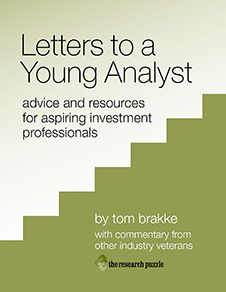
- Tuesday, May 13th, 2014
- march of the robots
-
So-called “robo-advisors” have been dominating the news in the investment advisory arena. Firms in that loosely-defined collection of businessesInvestmentNews | Michael Kitces walks through four different kinds of business models in this short article. use technology to standardize and automate parts of the investment and planning processes that had previously been completed with the aid of a financial advisor. The developments may seem parochial and of little interest to those in other corners of the investment ecosystem, but they portend broader changes across the landscape.
For their part, advisory firms have started to pay attention to the robo-advisors. That’s surely due to the increased coverage in the press, but there’s more at work. The clients of traditional advisors have started asking about the services — and in some cases they have pulled their assets.
Originally, the upstarts didn’t seem all that threatening to advisors, since it was thought they would primarily serve the people that couldn’t meet the asset minimums required by most firms. However, the discussion has evolved considerably and has started to focus more broadly on the nature of services provided and the cost of them.
That has triggered a public relations battle, with human advisors pointing out all of the things that they do that machines can’t (including, “We take you to lunch.”eMoney Advisor | Among “15 Things Human Advisors Do That Robo Advisors Can’t.”). Will this be yet another industry that software destroys?Abnormal Returns | There are a number of good links in this posting. How much damage will the robots do to the status quo?
To consider that, remember that most traditional advisors use algorithms too and the processes can be substantially the same as those used by robo-advisors. In fact, certain kinds of activities that are common at some advisory firms (for example, using high-fee proprietary products or attempting to select managers without devoting sufficient resources to the mission) can detract from the returns that could be received from a plain-vanilla approach.
There is a fair amount of overlap in the activities of the two camps — and in each case decisions tend to be made using the framework of modern portfolio theory. If that theory is tested further by market developments and found wanting, it won’t matter whether the exposures were suggested by a robotic advisor or a human one using the same approach.
There is a substantial difference in fees, however. Some advisors charge eye-popping rates for very simple strategies. The robots will feast on those situations, their inroads abetted by the advisory industry’s tendency to charge based upon assets under management rather than services delivered. A little arithmetic will show high-net-worth clients that they’re paying a lot for bundled services that may be more properly priced à la carte.
Good advisors are worth their weight in gold, but many have not developed a value proposition that can survive careful scrutiny or increased competition from man or machine (or some combination thereof). Advisors have some challenging discussions ahead about price and value — and they will need to rethink their business models. However, they are not the only ones; the same forces can be seen in other parts of the investment business.
In each area, the goal, as I wrote in Letters to a Young Analyst,Gumroad | The ebook is available for purchase on the Gumroad site. It includes ongoing quarterly updates. should be to “have the computers do what they are best at doing and humans do what they are best at doing.” Which brings me to “deep learning.”
My interest in the topic was prompted by a briefing from Inferential Focus.CFA Society Minnesota | The piece, “The Race to Robot Heaven … What? Deep Learning and the Progression of Machine Capabilities” is not available online. This link will tell you more about Inferential Focus. Deep learning is a gateway to true artificial intelligence, with computers going beyond the step-by-step instructions that have defined them thus far. Machines will be increasingly able to recognize language and images — and to make independent decisions in response. (There are many storiesMIT Technology Review | This publication named deep learning as one of the ten “breakthrough technologies” of 2013. and resourcesDeep Learning | This site will keep you busy for a while. online to help you get up to speed about deep learning.) Reading the Inferential Focus material, I realized that soon enough the line between what computers do best and humans do best may be drawn in an entirely different way.
If so, the robo-advisors of today will morph considerably and the human advisors will face an even tougher competitive environment. Similarly, the investment processes of asset owners and asset managers alike could look radically different in not too many years — and a relatively predictable industry where some things never seem to change could be disrupted in ways no one is talking about today.
I help investment organizations to identify emerging challenges and to think creatively about organizational design, so I am excited by the stunning possibilities on the horizon. But the industry and its organizations are not prepared for the disturbances ahead.
The robots seem to be marching in formation now. What happens when they learn to go off on their own?
